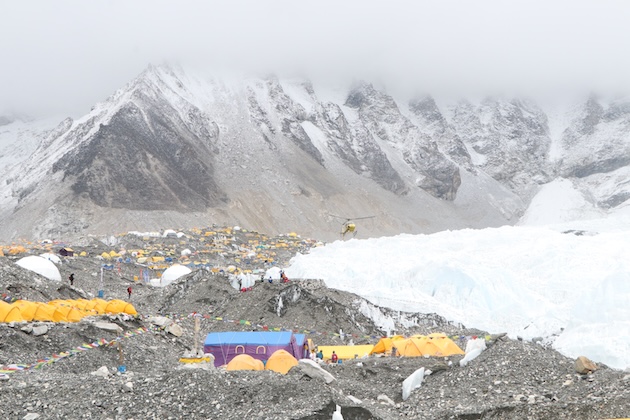KATHMANDU, Sep 16 (IPS) – When Kancha Sherpa, the sole surviving member of the first successful Mt Everest expedition, says it is time for Sagarmatha, as the world’s highest mountain in Nepal is known, to rest, isn’t it time for the world to listen? “That’s Mt Everest!” I heard this from a trekking guide to his trekking team. I stopped and asked him – who! He wasn’t our guide, but I walked up to him. He pointed his finger and showed me Mt Everest and I cried – I don’t know why. I was overwhelmed and humbled to finally see the world’s highest mountain – and it wasn’t from base camp, but from Thyangboche on the way back.
When I think of mountains, I immediately think back to that time when I was full of emotion and the numbers of people who went there. The Khumbu region, home to some of the highest mountains in the world, including Sagarmatha (Mt. Everest), sees an influx of climbers and trekkers, especially in spring, and concern is growing.
Last May I had the chance to visit and report on the region. One thing that struck me was the concern about the increasing number of climbers and trekkers. I was shocked by the number of people turning back and going to base camp. This got me thinking: is it sustainable for the region, which is already vulnerable to the impact of rising temperatures?
In recent years, the number of climbers and trekkers has been consistently high, and the influx has led to incidents of ““files” on Everest. Every year, more than 450 climbers from all over the world are granted permits by the Nepalese government to climb Mt. Everest, and this number is constantly growing. More than 50,000 people flock to the base camp every yearwhich I think is too much for an ecologically and geographically vulnerable area like Khumbu.
There I met Kancha Sherpa92, the only living member of the first successful Mt. Everest expedition team in 1953. He expressed his fears and said the mountain needs “peace” and “respect”.
“For the government, Everest is all about money,” Sherpa said. “And for climbers today, it’s all about making records.” At his home in Namche, Solukhumbu, Sherpa shared his frustration with the increased and largely commercialized mountaineering activities.
For Sherpas, the mountain is their goddess, their home. They worship her. I remember Kancha Sherpa saying sympathetically, “We are grateful. But our goddess is tired of human waste; she needs a rest.”
Throughout my reporting trip and after returning, Kancha Sherpa’s voice kept echoing in my head: the mountain needs peace and respect.
Yes, tourism and mountaineering are not only a way of livelihood for communities in Khumbu, but also an important source of income for the government of Nepal. It creates opportunities, even though locals are mostly forced to be guides or lend a helping hand to trekkers and climbers.
But at what cost, or is it sustainable? I don’t believe so. Science has long told us that the impact of rising temperatures is greater in the mountains. Reports say that the impact of climate change in the mountains of the Hindu Kush Himalaya (HKH) regionwhere the Sagarmatha Mountains are located, is unprecedented and largely irreversible. It means that changes in glaciers, snow and permafrost caused by global warming are extremely worrying and require urgent action.
But the massive influx of people into the Everest region is acting as a catalyst for the already fragile region, making it even more vulnerable to even worse situations.
Glaciers are retreating faster, creating glacial lakes that could explode in the future and wipe out everything in their path. The growing number of trekkers and climbers may be contributing to this disruption of natural phenomena.
In the region, not only experienced climbers such as Sherpas are voicing their concerns, but also visitors. Dr. Alex Balauta was one of them.
Balauta, who came from Austria, said: “It was a secret place for many years, but now it has become very commercial and crowded.” He expressed concern about the possible impact of overcrowding in the region and wanted the government to intervene appropriately to protect the sanctity of the Everest region.
I totally agree with him. In order to give the fragile geography peace and to keep it clean and secret, respecting the beliefs of the local communities, there should be some kind of limit on the number of people who can climb and hike in the region each year.
And there is hope for people like us, which came as a court order on April 26 (2024) The Supreme Court of Nepal ruled that the number of climbers and the climbing time should be based on the carrying capacity of the mountain.
I strongly believe that this verdict is historic and that it paves the way to cap the number of climbers on mountains including Sagarmatha. The government must act fast because it is too late and we all need to think critically, analyze and decide on the urgent question: How much is too much for Mount Everest?
I hope we all prioritize the needs of the mountains before our quest to conquer them. And I hope the government will listen to the loud voice of the decorated Sherpa: “Mountain needs rest!”
This opinion piece was published with support from the Open Society Foundations.
IPS UN Office Report
Follow @IPSNewsUNBureau
Follow IPS News UN Bureau on Instagram
© Inter Press Service (2024) — All rights reservedOriginal source: Inter Press Service

